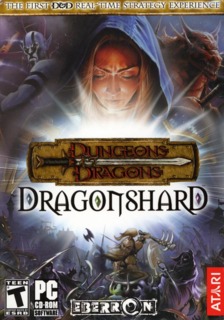Quality blend of RTS and RPG gameplay. Not without its flaws, but well worth a look for fans of the genre.
On its own merits, Dragonshard is an interesting blend of some of the most distinctive elements of Kohan II and Warcraft III. You don't build individual structures in Dragonshard; like Kohan II you have cities with predefined slots for buildings. Each city has four areas containing four slots, and you have to fill an area with four structures of the same type to maximize the level of the troop the structure produces. Instead of maximizing a troop's level, you can opt to build monuments that provide troop bonuses.
As they gain levels, units can support up to 4 expendable subsidiary soldiers. These subsidiary soldiers are not under your direct control and are added automatically when the unit is in the vicinity of your base, again similar to Kohan II's line of supply. The supporting soldiers can't travel underground, so gameplay in the underworld switches to a traditional rpg dungeon crawl, reminiscent of Warcraft III creep hunting.
Experience points in Dragonshard aren't assigned to the unit that made the kill; xp is assigned to a global pool which you use to level up a troop type. As a D&D fan I took awhile to get used to this method of leveling, but over time I came to appreciate the superior strategic control it gave me over my army's makeup and development.
One of the appeals of the Eberron campaign setting is that there's a great deal of scope for adventures involving complex intrigue, scheming and exotic locales; unfortunately this is an opportunity Dragonshard let slip. All we get with the included single player campaigns are: a) fight your way through a horde of enemies to capture a magic artifact, and b) defend your land from enemies trying to fight their way to a magic artifact you're sworn to protect. Pretty run-of-the-mill stuff, and the character development is more or less nonexistent. With only two seven map campaigns, the game is a little on the short side, although replayability is fair: each map has a number of optional sidequests and bonus point challenges.
Maps in the single player campaign are well designed and nicely sized - small enough to keep the action focused and intense but large enough to allow for exploration and strategic considerations. Do not expect to organize complex feint and flanking maneuvers as you would in Kohan II; the single player campaign mostly involves dungeon crawling and skirmishing to level up units, then hurling them en masse at the enemy base to wear it down. It's fun, and the rpg elements keep things varied and interesting, but the degree of strategic sophistication does not measure up to the best RTS games.
My biggest criticism against this game is its stability - I experienced a number of crashes after long gaming sessions and the occasional corrupted saved game. These problems were not significant enough to hinder my enjoyment of the game, and they're nothing a patch can't fix.
Visually the game is attractive and the interface works well; sound and voice acting are of a high standard. Gamers with aging machines approach with caution: I played on a 2.2 MHz rig with 512 MB RAM and a Radeon 9800 Pro and experienced slow load times and noticeable lag at times. Overall this is an excellent game with enough variety and novel features to keep RTS fans entertained.

